WELLFLEET — Walter Baron estimates he has built some 180 wooden boats, ranging in size from small rowboats to his largest, a 35-foot shallow-draft sailing boat from a custom design by Phil Bolger. He’s been at it since the mid-1970s, starting not long after he moved to Wellfleet from Western Massachusetts as a young man.
Baron says he’s turning his attention to building smaller, lighter boats. “I’m 74,” he says. “Crawling under a boat is easy, but the getting up part is hard.”
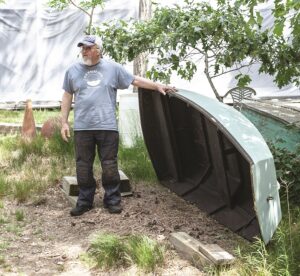
But old habits die hard. Currently, he’s working on a 20-foot sportfishing boat that’s so large he had to make a dedicated workspace for it by erecting a portable garage off one end of his cavernous shop. It’s a personal project that he’s working on with his son, Nicolas.
In the main part of his shop, he’s putting the finishing touches on a boat that’s more slender and simpler: a 16-foot Nauset Marsh skiff. Its subtle curves and glossy green surface are exquisite. Outside are a few of his smaller boats, including the second boat he ever built — a pram his father-in-law bought from him when he was just starting out.
When Baron moved to Wellfleet, he didn’t have much boating experience other than canoeing with the Boy Scouts and occasionally fishing with his father. “Not until I got here did I start experiencing the water,” he says. He started working as a carpenter, and although one of his first jobs was fixing the floats at the Wellfleet pier, it took him a few years to turn his carpentry skills and interest in boating into a one-man shop called Old Wharf Dory.
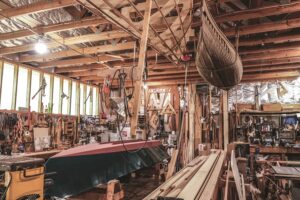
There was a recession, Baron recalls. “I thought building boats would be a recession-proof job,” he says, adding, “It didn’t quite work out that way.”
He began by reading a lot of books and repairing old boats. “I didn’t know anything,” he says.
Prams, which he describes as “old-style Scandinavian boats with two transoms and no pointy edges,” were among his first boats. A layman might refer to them as rowboats. To build the one outside his shop, he followed instructions in National Fisherman, a commercial fishing magazine.
The marine plywood of its interior is stained black, and he coated the mint-green exterior with fiberglass and epoxy when he rebuilt it a few years ago. The boat weighs between 70 and 80 pounds. “It fits in the back of a pickup truck,” says Baron, who has used it for shellfishing by launching it at the Wellfleet pier and rowing across to Chipman’s Cove to collect oysters. He also used it as a tender to reach moored boats. And when his two sons were small, they would row around Long Pond in it.
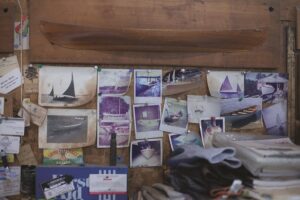
People have deep attachments to their wooden boats, Baron says. “I rebuilt a pram a guy’s father built from a kit that cost $50 in the 1950s,” he recalls. “It cost $4,000 to rebuild it. I could have built it new for $2,000, but he wanted the same boat.” His next project is also a restoration project, a family dinghy that a customer wants to restore for his grandchildren.
Historically, wooden boats dominated local fishing fleets and recreational boating on the Cape, but as fiberglass boats grew in popularity, wooden boats became less common. In the commercial fishing industry, complications over insuring wooden boats have made them increasingly rare. But wooden boats still have a devoted following.
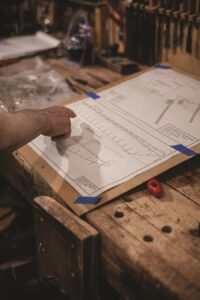
One misconception people have about wooden boats is that they leak, Baron says. And that you have to do a lot of work to keep them up. While that can be “kind of true if you have an old one that hasn’t been taken care of,” he says, wooden boats are actually easier to repair than fiberglass ones.
He prefers wooden boats because they look nice. “They’re not just white plastic,” he says. “Wood is a renewable resource,” he writes on his website. “Trees still grow, unlike oil.” Wooden boats also offer smoother sailing because they absorb vibrations, he says. And they’re often lighter weight — which means both fuel efficiency and ease.
Wooden boats have gotten a boost recently from a rise in amateur boatbuilding. Kits have become more accessible because of CNC (computer numerical control) routers, which use computer programs to cut molds for boats. Baron has nothing against the kits. A client from Provincetown recently purchased a kit for a dory and hired him to put it together. “It’s like putting a puzzle together in three dimensions,” he says.
Although Baron doesn’t have his own CNC router, his son Otis, a designer and woodworker who lives in Portland, Maine, has one that he’s been using to make cuts for the sportfishing boat his dad and brother Nicolas are building.
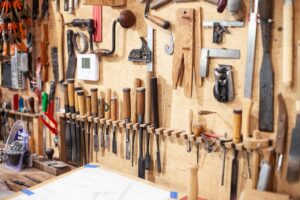
Baron has plenty of more traditional tools stationed around his shop, including a collection of Japanese hand tools, mostly saws, that he uses to refine small areas. He points to a paring chisel as a favorite. “I’ve had this for probably 30 years,” he says. “I use it quite a lot for fitting and trimming stuff.”
The sportfishing boat is nearly finished. Baron hopes it will be in the water within a month. He worked from the design of a North Carolina fishing boat and added a wheelhouse. “It has a lot of flare in the bottom,” he says of the V-shaped boat. “It’s a good rough water boat.”
Once this large project is behind him, Baron says he hopes to be out fishing in Cape Cod Bay. When he returns to land, he says, he’ll start on the smaller boats in earnest.
Editor’s note: An earlier version of this article, published in print on June 15, included an inaccurate reference to Walter Baron’s son. His name is Nicolas, not “Norman.”



